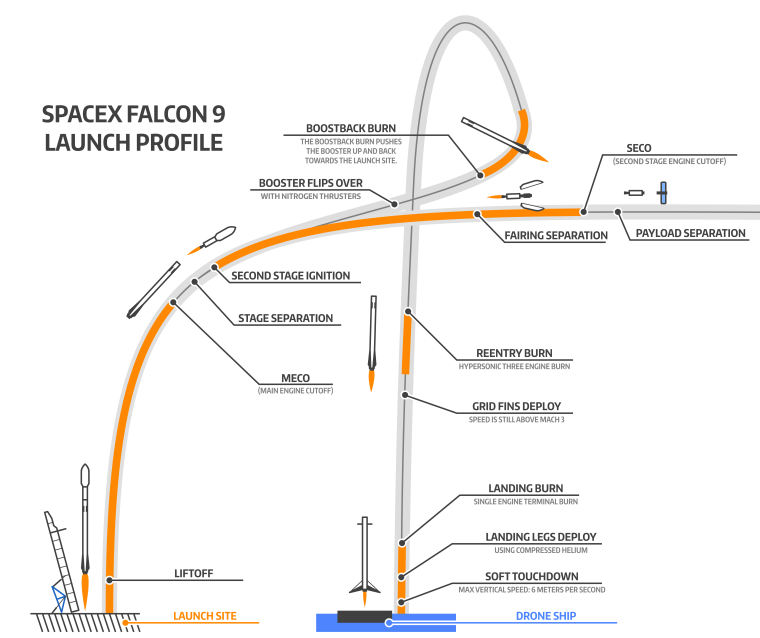SpaceX launched a Falcon 9 rocket that successfully put a Dragon cargo capsule in orbit on Saturday, but its unprecedented attempt to land the uncrewed rocket's first stage at sea ended with a crash.
The primary goal of the launch was to send more than 5,000 pounds (2,300 kilograms) of supplies, equipment and experiments to the International Space Station aboard the Dragon. That part of the mission unfolded flawlessly.
After the Dragon and the Falcon's second stage separated and went on their way, the 14-story-tall first stage was programmed to try flying itself back to an "autonomous spaceport drone ship" sitting about 200 miles off Florida's Atlantic coast. SpaceX's billionaire founder, Elon Musk, said in a Twitter update that the stage "made it to drone spaceport ship, but landed hard."
"Close, but no cigar this time," he said.
Such a maneuver had never been tried before — and if the procedure becomes routine, it could mark a giant leap toward rocket reusability and low-cost spaceflight. Musk has said making rockets fully reusable could reduce the cost of getting to orbit to 1 percent of what it is today. That would hasten Musk's dream of creating colonies on Mars and making humanity a "multiplanet species."
The Falcon 9 rose into a dark sky at 4:47 a.m. ET from Cape Canaveral Air Force Station in Florida. It almost blasted off on Tuesday — but a problem with an engine-steering actuator on the rocket's second stage forced a last-minute scrub. SpaceX replaced the balky part, and Saturday's countdown went smoothly.
Attempt 'bodes well for future'
The landing attempt came about 10 minutes after liftoff. After stage separation, at an altitude of well more than 60 miles (100 kilometers), the first stage relit its rocket engines for three maneuvering burns to slow down the supersonic descent and steer the rocket to a vertical landing on the drone ship.
The first stage was equipped with fold-out stabilizing fins and landing legs to facilitate the maneuver. The robotic drone ship has a 300-foot-long, 170-foot-wide landing platform — and it's designed to stabilize itself, even in heavy seas, thanks to a set of underwater thrusters. But even before the launch, Musk said the chance of success was only 50-50 at most.
No one was aboard the drone ship during the landing maneuver, due to safety concerns.
SpaceX had tested elements of the maneuver during previous Falcon 9 launches by bringing the first stage down for a "soft splashdown," but this was the first attempt to have the stage land intact. Eventually, SpaceX would have rocket stages fly themselves back for touchdown on a land-based pad.

For a larger version of the graphic and a full explanation of the launch profile and its significance, check out 'The Future of Space Launch Is Near' by John Gardi and Jon Ross.
Musk has vowed to continue testing the landing maneuver during future Falcon 9 missions. Despite the hard landing, he said Saturday's test "bodes well for the future."
Space consultant Charles Lurio, editor of The Lurio Report, said in an email that he was "gleeful" about the test's outcome "because it's wonderful that they got as far as they did in a first try."
"It's like we’re back in the era of early aircraft testing — plenty more chances to get it 100 percent right at low cost, and at no cost to the taxpayer," Lurio told NBC News.
Hans Koenigsmann, SpaceX's vice president of mission assurance, emphasized before the launch that success or failure would not be judged by whether or not the first stage is recovered. "The main mission is absolutely to get cargo to the station," he said.
What's going to the station?
This is SpaceX's fifth resupply mission under the terms of a $1.6 billion contract with NASA that covers 12 flights in all. The cargo run is particularly important in the wake of October's blow-up of Orbital Sciences Corp.'s Antares rocket, which was supposed to send a Cygnus cargo capsule to the space station. Some payloads have been shifted to SpaceX's Dragon to make up for that loss.
The Dragon shipment includes duplicates of 17 student experiments that were on the ill-fated Cygnus. The gumdrop-shaped capsule also carries experiments that will study the immune systems of fruit flies and the wound-healing capabilities of flatworms in the space environment.
One of the most important payloads is a laser remote-sensing experiment that will monitor the worldwide distribution of clouds and aerosols from orbit. The $15 million Cloud-Aerosol Transport System, or CATS, is due to be set up on the space station's exterior later this month.
The cargo also includes more mundane supplies, such as the food, water and clothing needed by the space station's six residents. The crew is scheduled to snare the Dragon and hook it up to the orbital outpost on Monday. Over the course of a month, the capsule will be unloaded, and then loaded up again with cargo destined for return to Earth.